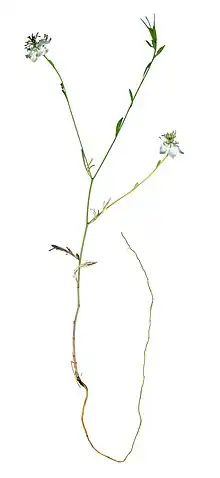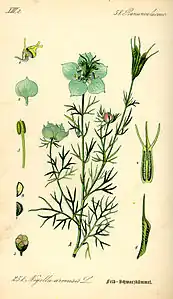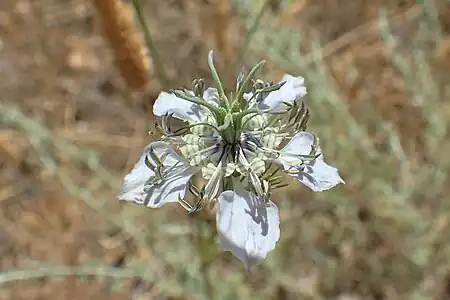| Nigella arvensis | |
|---|---|
 | |
| Scientific classification | |
| Kingdom: | Plantae |
| Clade: | Tracheophytes |
| Clade: | Angiosperms |
| Clade: | Eudicots |
| Order: | Ranunculales |
| Family: | Ranunculaceae |
| Genus: | Nigella |
| Species: | N. arvensis |
| Binomial name | |
| Nigella arvensis | |
| Synonyms[1] | |
|
List
| |
Nigella arvensis, the field nigella or wild fennel flower, is a species of flowering plant in the family Ranunculaceae.[2] It is native to North Africa, central, southern and eastern Europe, the Caucasus region, and the Middle East as far as Iran, and has gone extinct in Switzerland and Crete.[1] It is a minor crop, used locally as a substitute for Nigella sativa, black caraway.[3]
Subtaxa
The following subtaxa are accepted:[1]
- Nigella arvensis var. anatolica Zohary – Turkey
- Nigella arvensis var. iranica Zohary – Iran
- Nigella arvensis subsp. latilabris (Zohary) Greuter & Burdet – Israel
- Nigella arvensis var. longicornis (Zohary) C.C.Towns. – Turkey, Levant, Iraq
- Nigella arvensis subsp. negevensis (Zohary) Greuter & Burdet – Israel
- Nigella arvensis var. oblanceolata P.H.Davis – Turkey
- Nigella arvensis subsp. palaestina (Zohary) Greuter & Burdet – Turkey, Levant
- Nigella arvensis var. simplicifolia Zohary – Iraq
Gallery
 Botanical illustration
Botanical illustration Close-up of flower
Close-up of flower In its habitat
In its habitat
References
- 1 2 3 "Nigella arvensis L." Plants of the World Online. Board of Trustees of the Royal Botanic Gardens, Kew. Retrieved 20 September 2021.
- ↑ "Nigella arvensis wild fennel flower". The Royal Horticultural Society. 2021. Retrieved 20 September 2021.
- ↑ Weiss, E. A. (2002). Spice Crops. Cabi Publishing. p. 357. ISBN 9780851996059.
This article is issued from Wikipedia. The text is licensed under Creative Commons - Attribution - Sharealike. Additional terms may apply for the media files.